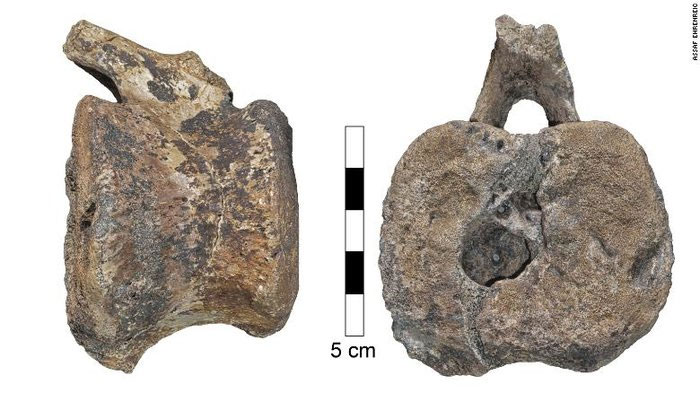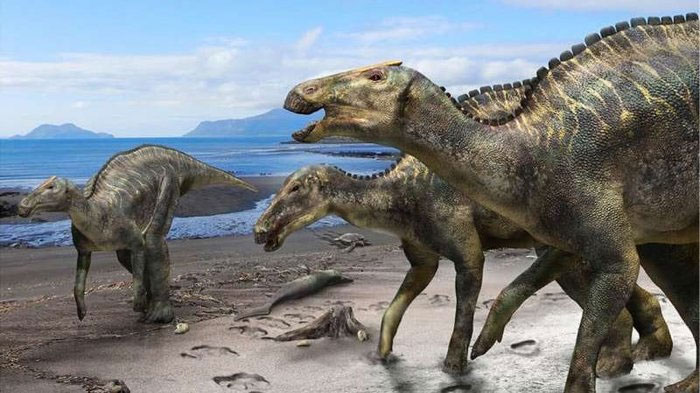Detecting traces of rare cancer in dinosaur fossils
The germ of a disease that still exists in society today has been found in the fossil of a platypus dinosaur 66 million years old.
When studying the two-vertebrae fossils of the hadrosaur at the Dinosaur Park in southern Alberta, Canada, researchers at Tel Aviv University in Israel discovered unusual worm holes. They continue to compare the vertebra of the specimen to the bones of two patients with LCH (Langerhans cell histiocytosis) , a rare disease that causes discomfort and pain in young children, especially boys.

The damage is caused by LCH syndrome on dinosaur bones.
Diagnosing diseases based on bones and fossils is very complicated, because the trace appearing on the specimen can be caused by many diseases, it is difficult to determine the exact cause. However, according to Dr. Hila May, head of the evolutionary medicine laboratory of the Faculty of Medicine (Tel Aviv University), the damage caused by LCH on the patient's bone is quite characteristic, consistent with the above characteristics. bone fossils of platypus dinosaurs.
'The new technology allows us to examine the damage in the skeletal structure of the specimen, as well as reshape the tumor shape and the vascular system that nourishes them , ' she said. 'The analysis has proven that this is indeed LCH. This is the first time this syndrome has been confirmed to appear on dinosaurs' bodies . In humans, LCH is considered a rare form of cancer . However, May said experts are still arguing about the concept, because in some cases, patients with LCH may go away on their own.

Hadrosaur Platypus.(illustration).
'Patients with LCH syndrome are usually children from 2 to 10 years old. When infected, tumors will begin to appear in the patient's bones causing pain. But, in most cases, these tumors are likely to disappear on their own without a doctor's intervention, ' she said.
Adult platypus is about 10 meters tall and weighs several tons. These dinosaurs often gathered in groups, which existed between 66 and 80 million years ago. Like many other creatures, dinosaurs were sometimes infected, but the data on their diseases collected through fossil research is still too little. However, scientists have found evidence that some tyrant dinosaurs once had gout, and that the herbivorous dinosaur Iguanodon may have had osteoarthritis.

Dr. Hila May.
Cancer is a complex and difficult to diagnose based on fossils, but scientists have reason to believe that dinosaurs are also victims of this disease. The authors say the findings could help make world medicine more progressive, through the long-term development of the field of disease development and symptoms. Once we understand the manifestations of the disease in many different species and how they survive the natural screening process, we can find newer, more effective ways to cope with diseases. zoonotic, such as COVID-19, HIV and tuberculosis.
- Fossil findings show that cancer has existed since prehistoric times
- Malignant bone cancer was found in the Triassic turtles
- Detection of extremely rare dinosaur fossils in the UK
- Australia found fossils tens of millions of years old
- The 66 million-year-old rare dinosaur fossil was found in Colorado
- Detecting the first individual cavities dinosaurs
- 110 million year old dinosaur fossils
- Traces of dinosaurs are rare in the Arabian Peninsula
- Detecting complete bone fossils of a dinosaur
- The dinosaur fossil is about the size of a chicken
- Repeatedly discovered dinosaur fossils in Canada
- Detecting dandruff in dinosaur fossils 125 million years
- Close up of the world's largest dinosaur park
- Can the gender of dinosaur fossils be determined?
 Discovered an ancient centipede fossil 99 million years old
Discovered an ancient centipede fossil 99 million years old Discovered bat-like dinosaurs in China
Discovered bat-like dinosaurs in China Discovered a 200-year-old bronze cannon of the coast
Discovered a 200-year-old bronze cannon of the coast Discover 305 million-year-old spider fossils
Discover 305 million-year-old spider fossils